Photoelectric effect experiments are performed using three different metal plates p,q and r having work functions ϕp=2.0eV,andphi_q=2.5eV andphi_(tau) =3eV and wavelengths of 550 nm,550nm, and 350 nm with equal intensities , illuminates each of the plates . The correct I - V graph for the experiment is (Take hc = 1240 eV nm)


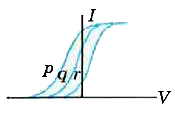

The correct Answer is:D
To solve the problem regarding the photoelectric effect experiments with three different metal plates (P, Q, and R), we need to analyze the given data and apply the principles of the photoelectric effect. Here's a step-by-step solution:
Step 1: Understand the Work Functions and Wavelengths
We have three metal plates with the following work functions:
- Plate P: ϕp=2.0eV
- Plate Q: ϕq=2.5eV
- Plate R: ϕr=3.0eV
The wavelengths of light illuminating these plates are:
- Plate P: λp=550nm
- Plate Q: λq=550nm
- Plate R: λr=350nm
Step 2: Calculate the Energy of the Incident Photons
Using the formula for the energy of a photon:
E=hcλ
where hc=1240eV⋅nm.
For Plate P and Q (550 nm):
Ep=Eq=1240550≈2.25eV
For Plate R (350 nm):
Er=1240350≈3.54eV
Step 3: Calculate the Maximum Kinetic Energy
The maximum kinetic energy of the emitted electrons can be calculated using:
KEmax=E−ϕ
For Plate P:
KEmax,P=Ep−ϕp=2.25−2.0=0.25eV
For Plate Q:
KEmax,Q=Eq−ϕq=2.25−2.5=−0.25eV(no photoelectrons emitted)
For Plate R:
KEmax,R=Er−ϕr=3.54−3.0=0.54eV
Step 4: Calculate the Stopping Potential
The stopping potential V0 can be calculated using:
V0=KEmaxe
For Plate P:
V0,P=0.25V
For Plate Q:
V0,Q=no emission(V0,Q=0V)
For Plate R:
V0,R=0.54V
Step 5: Analyze the I-V Characteristics
- For Plate P, we will have a stopping potential of 0.25V and a current that saturates after reaching this potential.
- For Plate Q, there will be no current since the energy of the incident photons is less than the work function.
- For Plate R, the stopping potential is 0.54V, and it will also saturate at this value.
Conclusion
The I-V graph will show:
- A current for Plate P that saturates at 0.25V.
- No current for Plate Q.
- A current for Plate R that saturates at 0.54V.
Thus, the correct I-V graph will show:
- A line for Plate P saturating at 0.25V.
- A flat line for Plate Q (no current).
- A line for Plate R saturating at 0.54V.
We have three metal plates with the following work functions:
- Plate P: ϕp=2.0eV
- Plate Q: ϕq=2.5eV
- Plate R: ϕr=3.0eV
- Plate P: λp=550nm
- Plate Q: λq=550nm
- Plate R: λr=350nm
Using the formula for the energy of a photon:
E=hcλ
where hc=1240eV⋅nm.
Ep=Eq=1240550≈2.25eV
Er=1240350≈3.54eV
The maximum kinetic energy of the emitted electrons can be calculated using:
KEmax=E−ϕ
KEmax,P=Ep−ϕp=2.25−2.0=0.25eV
KEmax,Q=Eq−ϕq=2.25−2.5=−0.25eV(no photoelectrons emitted)
KEmax,R=Er−ϕr=3.54−3.0=0.54eV
The stopping potential V0 can be calculated using:
V0=KEmaxe
V0,P=0.25V
V0,Q=no emission(V0,Q=0V)
V0,R=0.54V
- For Plate P, we will have a stopping potential of 0.25V and a current that saturates after reaching this potential.
- For Plate Q, there will be no current since the energy of the incident photons is less than the work function.
- For Plate R, the stopping potential is 0.54V, and it will also saturate at this value.
The I-V graph will show:
- A current for Plate P that saturates at 0.25V.
- No current for Plate Q.
- A current for Plate R that saturates at 0.54V.
- A line for Plate P saturating at 0.25V.
- A flat line for Plate Q (no current).
- A line for Plate R saturating at 0.54V.
Topper's Solved these Questions
- BOOK - MODERN PUBLICATIONCHAPTER - DUAL NATURE OF RADIATION AND MATTER EXERCISE - COMPETITION FILE (OBJECTIVE TYPE QUESTIONS ( C - Multiple Choice Questions) )8videos
DUAL NATURE OF RADIATION AND MATTER
- BOOK - MODERN PUBLICATIONCHAPTER - DUAL NATURE OF RADIATION AND MATTER EXERCISE - COMPETITION FILE (OBJECTIVE TYPE QUESTIONS ( D - Multiple Choice Questions) )5videos
DUAL NATURE OF RADIATION AND MATTER
- BOOK - MODERN PUBLICATIONCHAPTER - DUAL NATURE OF RADIATION AND MATTER EXERCISE - COMPETITION FILE (OBJECTIVE TYPE QUESTIONS ( B - Multiple Choice Questions) (JEE (Main) & Other State Boards for Engineering entrance))18videos
DUAL NATURE OF RADIATION AND MATTER
- BOOK - MODERN PUBLICATIONCHAPTER - CURRENT ELECTRICITYEXERCISE - Chapter Practice Test15videos
CURRENT ELECTRICITY
- BOOK - MODERN PUBLICATIONCHAPTER - ELECTRIC CHARGES AND FIELDS EXERCISE - Chapter Practice Test15videos
ELECTRIC CHARGES AND FIELDS
Similar Questions
In a photoelectric effect experiment, the graph between the stopping potential (V) and frequency (v) of the incident radiations on two different metal plates P and Q are shown in plates, P and Q has greater value of work function ? (ii) What does the slope of the lines depict?
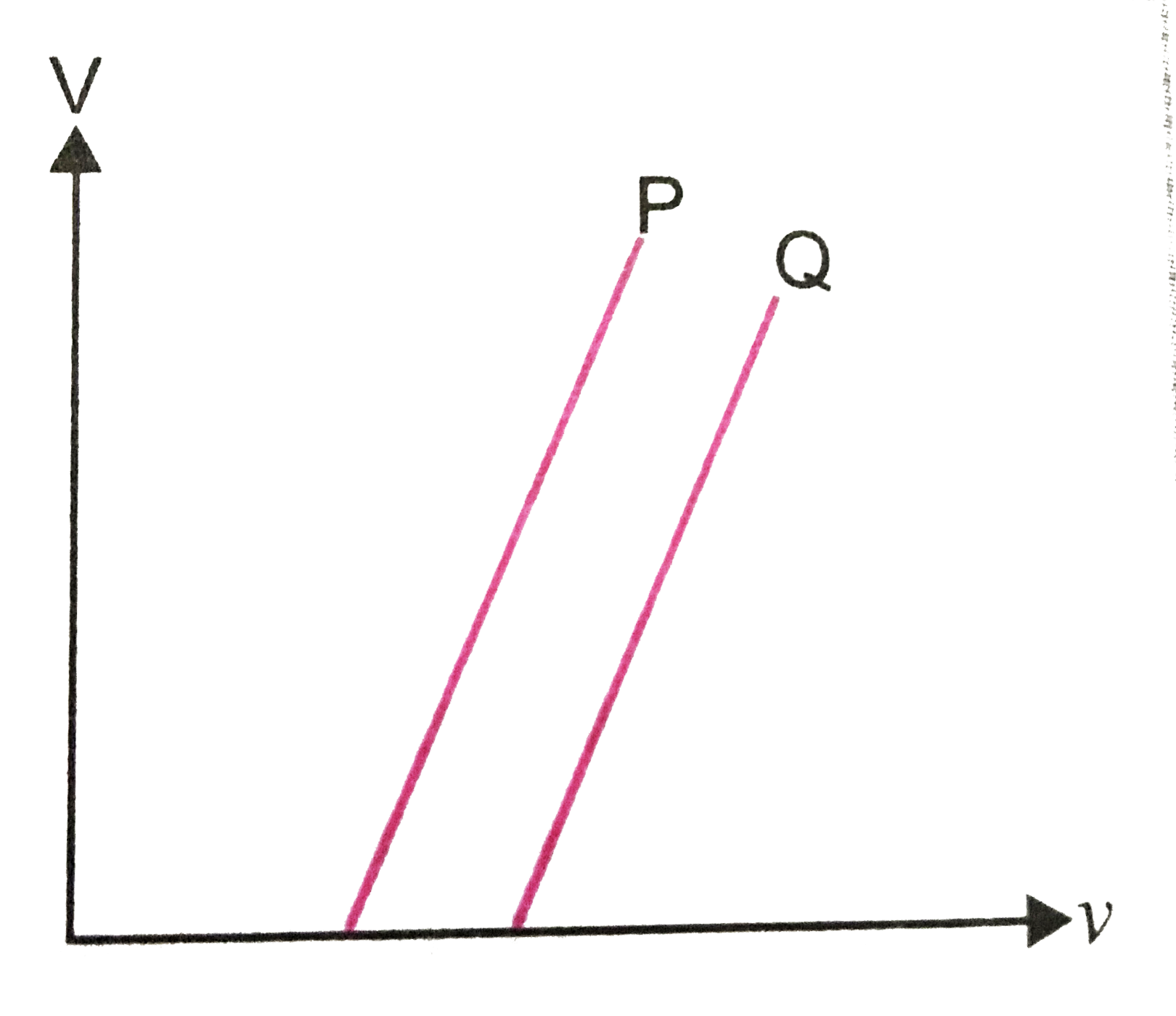 View Solution
View SolutionThe graph between 1/λ and stopping potential ( V ) of three metals having work functions ϕ1,ϕ2 and ϕ3 in an experiment of photoelectric effect is plotted as shwon in the figure. Which of the following statement (s) is / are correct ? [Here λ is the wavelength of incident ray ].
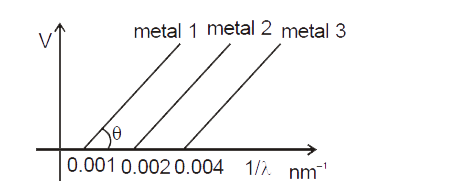 View Solution
View Solution
Knowledge Check
- Question 1 - Select One
photoelectric affect experiments are performer using ther different medal plates p,q andr having work functionphi_(p) = 2.0 eV, phi_(e) = 2.5 eVandphi_(r) = 3.0 eVrespectivelyAlightbeamconta∈∈gwave≤n>hof550nm , 450 nmand350nm withequal∫ensitiesilluminateseachoftheplate.Thecorrect1 -Vgraphfortheexperimentis [Take hc = 1240 eV nm]
A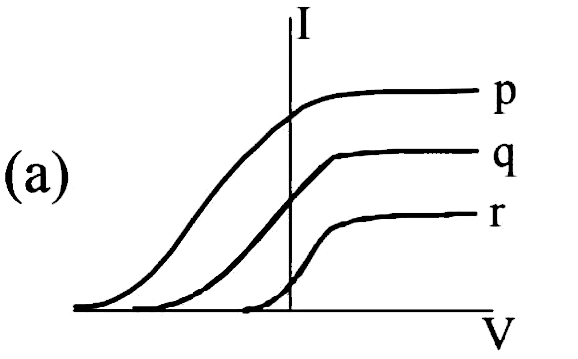 B
B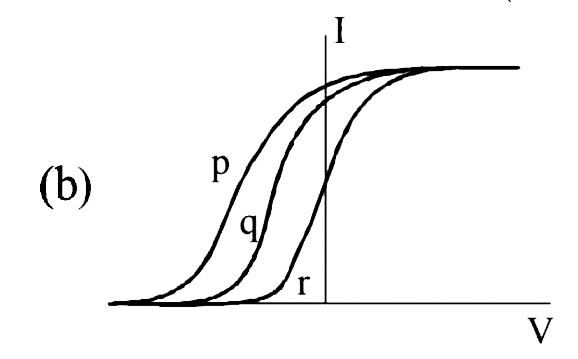 C
C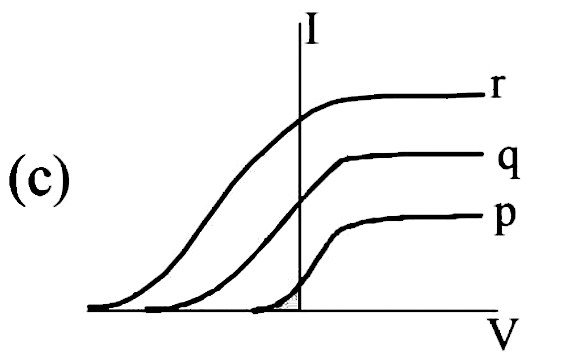 D
D
- Question 2 - Select One
If Photon having wavelength 6.2nmwas allowed to strike a metal plate having work function 50eV then calculate wavelength associated with emitted electron :
A1×10−10mB2×10−10mC3×10−18mD4×10−34m - Question 3 - Select One
A light beam of interest 3.01×10−3Wm−2 is incident normally on the square -sapped metal surface of side 1 cm and with work function 2 eV . The intensity of light is equal distributed among the three constituents' wavelength , 400 nm, 550 nm and 650 nm. Each photon emits one electron without any loss in the energy.
Choose the correct option from the following regarding the photoelectric emission.AElectrons emitted due to light of wavelength 400 nm onlyBElectrons emitted due to light of wavelength 650 nm onlyCElectrons emitted due to light of wavelengths 440 nm and 550 nm onlyDElectrons emitted due to light of wavelengths 550 nm and 650 nm only
Light of wavelength 350 nm falls on a metal having work function of 2eV. What is maximum possible magnitude of linear momentum of ejected electron ?
View SolutionIn a photo electric set up the radiation from Balmer series of hydrogen atoms are Incident on a metal of work function 2 eV. Find wavelength of incident radiations lying between 450 nm to 700 nm. Find the maximum kinetic energy of the photoelectron emitted (hc1242 eV nm).
View Solution(a) In a photoelectric experiment, the collector plate is at 2.0V with respect to the emitter plate made of copper (ϕ=4.5eV) . The emitter is illuminated by a source of monochromatic light of wavelength 200 nm. Find minimum and maximum kinetic energy of the photoelectrons reaching the collector.
(b) A small piece of cesium metal (ϕ=1.9eV) is kept a distance of 20 cm from a large metal plate having a charge density of 8.85×10−9C/m2 on the surface facing the cesium piece. A monochromatic light of wavelength 400 nm is incident on the cesium piece. Find minimum and the maximum kinetic energy of the photoelectrons reaching the large metal plate. Neglect any change in the electric field due to the presence of small piece of cesium.View SolutionIn a photoelectric effect experiment, a metallic surface of work function 2.2 eV is illuminated with a light of wavelength 400 nm. Assume that an electron makes two collisions before being emitted and in each collision 10% additional energy is lost.
Q. Find the kinetic energy of this electron as it comes out of the metal.View SolutionWhen the voltage applied to an X-ray tube increased from V1=15.5kV to V2=31kV the wavelength interval between the Kα line and the cut-off wavelength of te continuous X-ray spectrum increases by a factor of 1.3. If te atomic number of the element of the target is z. Then the value of z13 will be: (take hc=1240eVnm and R=1×107m)
View Solution

